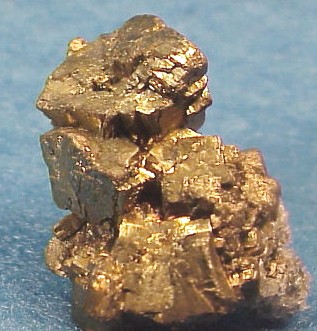The Mineral chalcopyrite

Chalcopyrite has a golden yellow color, which often resembles Gold. However, its physical properties such as streak and tenacity are very different from Gold and can easily distinguish it. Chalcopyrite is a beautiful mineral, with good crystals being fairly common. It is also readily available, with quality specimens being surprisingly affordable.
"Peacock Ore" which is sold to many amateur mineral collectors often as a variety of Bornite, is in fact almost always Chalcopyrite treated with
acid to produce an iridescent tarnish. Though some Chalcopyrite is naturally iridescent, wild colors such as strong blues and purples are usually formed from acid treatment.
Color
Brass yellow to golden yellow; sometimes dark brown to black. Tarnishes to a multicolored purple, blue, and red.
Crystal System
Tetragonal
Properties
Streak
Black with a slightly green tinge |
Hardness
3.5 - 4 |
Transparency
Opaque |
Specific Gravity
4.1 - 4.3 |
Luster
Metallic |
Cleavage
Indiscernible |
Fracture
Uneven |
Tenacity
Brittle |
Other ID Marks
Tarnishes to an iridescent purple, blue, and red. |
Varieties
-
Term used to describe Chalcopyrite or Bornite with a colorful iridescent tarnish effect, usually artificially enhanced with acid. Most Peacock Ore is sold as Bornite, when in fact it usually produced from acid-treating Chalcopyrite.
Uses
Chalcopyrite is the main ore of copper.
Chalcopyrite is sometimes polished into beads and pendants as cheap jewelry.
Noteworthy Localities
Chalcopyrite is a fairly common mineral, and therefore only the finest of localities will be mentioned. Large, well shaped crystals occur in numerous places in Cornwall, England, especially at the Carn Brea area. Baia Sprie (Felsobanya) and Kapnick both in Maramures Co., are famous Romanian occurrences. Very large crystals come from Krushev Dol, in the Rhodope Mountains of Bulgaria. In the Dreislar Mine, North Rhine-Westphalia, Germany, small Chalcopyrite crystals on white coxcomb Barite occur as an excellent combination with beautiful contrast. In China, large crystals occur at the Yaogangxian Mine, Hunan Province.
Many fine Chalcopyrite crystals occur in Zacatecas Mexico; Concepción del Oro and San Martín are noteworthy. The Huaron Mine in Cerro del Pasco, Peru is also a classic locality.
In the U.S., the Tri-state district of Kansas, Oklahoma, and Missouri has provided the important Chalcopyrite localities of Joplin, Jasper Co., Missouri; Picher, Ottawa Co., Oklahoma; and Treece, Cherokee Co., Kansas. The
Sweetwater Mine, Reynolds Co., Missouri produces small sparkling crystals, with some having a natural blue iridescence. Other excellent Chalcopyrite occurrences are the Gilman District, Eagle Co., Colorado; Ouray, Ouray Co., Colorado; and Ellenville, Ulster Co., New York. The Chimney Rock Quarry in Bound Brook, Somerset Co., New Jersey, has produced unique reniform blobs; and the the French Creek Mine in Chester Co., Pennsylvania has produced large distorted and highly tarnished crystals that are highly sought after by collectors.
Distingushing Similar Minerals
Pyrite and Marcasite - Paler color, harder (6 - 6½).
Gold - Nonbrittle, much heavier (15.5 - 19.3).
Bornite - Usually darker in color, more tarnish.